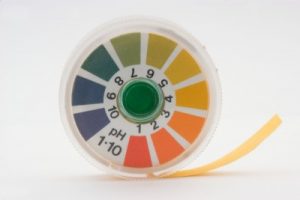
The pH of all living things is a key element critical to its survival.
Plants, animals, insects, and water.
Your body pH is something that you should monitor periodically to maintain good health, to regain lost immunity, and to maintain your proper weight.
The farther your pH travels from a healthy balance, more health problems can develop, and that includes cancer.
How Does pH work?

An acidic pH has a low ability to attract hydrogen ions, while an alkaline pH has a high ability to attract hydrogen ions.
The “p” stands for potential and “H” stands for hydrogen. This means that your pH is the potential for you to attract hydrogen ions that secure a balance for good health.
Each different type of liquid in your body has its own pH. This means that your blood pH is different from your stomach pH.
The pH scale for fresh water ranges from 0-14 with 7.0 pH designated as perfectly balanced. In the past, people “assumed” that a healthy body pH was that of fresh water – 7.0, but as an environmental engineer and nutritionist, I know that this is an alkaline level that’s very hard to maintain.
So, let’s make this practical and easy.
According to my research, an average, healthy body pH should be between 6.4 and 6.6 because people are salt water animals – we drink fresh water to keep the sodium from depositing as a solid inside of our bodies. Drinking enough fresh water keeps solids in solution – this prevents hardening of the arteries and kidney stones.
A pH below 6.4 is dropping to the acidic side, while readings above 6.6 are climbing alkaline.
Acid dissolves nutrients before they can be assimilated; alkalinity hardens nutrients into solid deposits. The balance between the two is what secures health.

Why Blood pH Is Higher
Your body pH is slightly lower than the pH of your blood because you naturally have acids circulating within your body. In fact, each of your body fluids has its own specific pH value.
Your blood, for example, has a more alkaline pH balance averaging between 7.1 and 7.4. because you don’t have acid in your blood, thank goodness. But, you have lots of acid in your stomach, which protects toxins from getting into your liver and your blood.
The pH of the gastric acid in your stomach and within your gastrointestinal tract is between 1.5 to 3.5.
Now that’s acidic!
Your body monitors this acid using a process called the alkaline tide, which is when your cells release bicarbonate into your bloodstream to increase the pH in your blood.
Amazing how your body works to maintain its own balance.
Determine Your pH

There are a variety of ways to determine your body’s pH. The most practical and inexpensive method is to find the pH level of your urine and saliva using litmus paper typically used for an aquarium or swimming pool.
Your body pH will vary with what you eat, so I recommend measuring both the pH of your saliva and your urine twice a day – when you get up in the morning before you eat or drink anything, and the last thing before bed after you’ve eaten who knows what during the day.
Keep in mind that when determining your body’s pH, you want to look at the averages and eating trends over a specific period of time.
My pH Test Kit
To make this process an easy part of your health regimen, I wrote a tutorial/instructional pH Test Program that includes:
- a detailed explanation how your pH works and how to maintain a balanced body pH;
- the 75/25 Eating Chart to help you select the right foods for your pH;
- a form to record both your urine and saliva pH readings over a ten-day period.

75/25 Eating Plan
My 75-25 Eating Plan will help you select the right pH balanced foods based on your individual pH because you must adjust your correct proportions of alkaline vs. acidic food choices at every meal and snack.
Keep in mind, you can eat both acidic and alkaline foods at each meal, but it is important to keep the proportions of acid versus alkaline as close to your specific body pH needs as possible.
A good Rule-of-Thumb is to eat 75 percent raw or steamed foods to 25 percent cooked foods at each meal – the raw foods have not lost their nutrients and enzymes to cooking.
A body pH between 6.4 and 6.6 as a healthy, and easy, way to maintain your health.
___________________________
If you want to learn more about your pH and disease prevention, contact me at janethull.com. Remember that you are never alone when you are looking for good health!
Gain access to all of my online programs, ongoing support, monthly Q&A, and more. I look forward to supporting you on your journey to alternative health and wellness.
_____________
Disclaimer: This article is for informational purposes only, and is educational in nature. The FDA may not have evaluated some of the statements. This article is not intended to diagnose, treat, cure, or prevent any disease. Please discuss with your own, qualified health care provider before adding supplements or making any changes to your dietary program.
Before taking vitamins, consult your doctor; pre-existing medical conditions or medications you are taking can affect how your body responds to multivitamins.
You have our permission to reprint this article if you attribute us with a live back-link to this article and the youtube links. https://janethull.com/